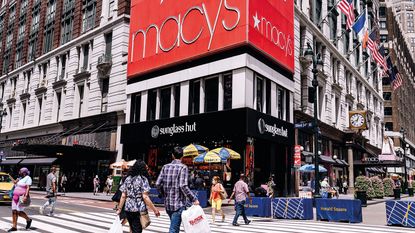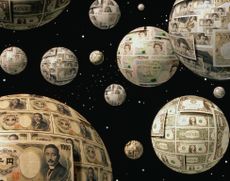US stockmarkets shrug off signs of overheating
Signs of overheating in the markets are everywhere, but that didn't stop US stocks hitting new record highs last week.

The stockmarket “bubble-o-meter is flashing bright red”, says John Authers on Bloomberg. Signs of froth are everywhere, from the record number of fund managers telling a Bank of America survey that they are making risky bets to wild swings in the price of bitcoin, previously a harbinger of market turning points.
Biden goes big
US stocks celebrated Joe Biden’s inauguration as US president last week by hitting new record highs, says Randall Forsyth in Barron’s. The S&P 500 has gained more than 4% since the start of the year. The bull market is riding an optimistic “triumvirate”.
First, monetary policy remains exceptionally supportive: the M2 gauge of the US money supply grew by an annualised 25.1% last month. Second, the vaccine trade is still going strong. But most importantly, third is the new president’s enormous $1.9trn stimulus plan.
Subscribe to MoneyWeek
Subscribe to MoneyWeek today and get your first six magazine issues absolutely FREE

Sign up to Money Morning
Don't miss the latest investment and personal finances news, market analysis, plus money-saving tips with our free twice-daily newsletter
Don't miss the latest investment and personal finances news, market analysis, plus money-saving tips with our free twice-daily newsletter
“That’s a lot of money,” says The New York Times. The plan would include direct $1,400 payments to all US households and enhanced unemployment benefits to be funded entirely through extra government borrowing. It is about twice the size of Barack Obama’s post-financial crisis stimulus bill and comes on top of the $2.9trn already spent on Covid-19 relief.
Biden’s plan would end up overheating the economy, says The Economist. The US spent about 14% of its GDP on stimulus last year, more than the likely fall in output caused by the virus. Biden’s plan could see relief spending running at about $300bn a month during the first three quarters of this year, far more than a monthly GDP shortfall of about $80bn. When the pandemic ends and US households deploy their $1.6trn savings pile, there will be too much cash chasing too few goods and services. That said, there is a good chance that Congress will chop the bill down somewhat before it is finally approved.
Economy up, markets down?
It’s a similar story on this side of the pond, says Liam Halligan in The Daily Telegraph. Joe Biden and Boris Johnson might make awkward political bedfellows, but they have at least one thing “in common”: spend, spend, spend. The UK Treasury is also borrowing record amounts – £271bn so far this fiscal year, compared to £60bn at the same time in 2020. Britain’s national debt is going above 100% of GDP, “a first in our peacetime history”. This fiscal and monetary cocktail is likely to drive an economic boom later this year.
But will the stockmarket join in? asks Justin Lahart in The Wall Street Journal. Last year’s brazen gains were a reminder that “the stockmarket’s link to the economy can be as thin as tissue paper”. As big business and tech loses its lockdown edge, could those gains reverse this year?
History shows that “protracted bear markets” rarely happen at the start of a new economic cycle, although there were exceptions in 1980 and 1946. Then again, we haven’t had such a devastating pandemic for 100 years either. Those betting that 2021 will deliver stockmarket nirvana could be making a “costly” mistake.
-
 Coventry Building Society bids £780m for Co-operative Bank - what could it mean for customers?
Coventry Building Society bids £780m for Co-operative Bank - what could it mean for customers?Coventry Building Society has put in an offer of £780 million to buy Co-operative Bank. When will the potential deal happen and what could it mean for customers?
By Vaishali Varu Published
-
 Review: Three magnificent Beachcomber resorts in Mauritius
Review: Three magnificent Beachcomber resorts in MauritiusMoneyWeek Travel Ruth Emery explores the Indian Ocean island from Beachcomber resorts Shandrani, Trou aux Biches and Paradis
By Ruth Emery Published
-
 The industry at the heart of global technology
The industry at the heart of global technologyThe semiconductor industry powers key trends such as artificial intelligence, says Rupert Hargreaves
By Rupert Hargreaves Published
-
 Three emerging Asian markets to invest in
Three emerging Asian markets to invest inProfessional investor Chetan Sehgal of Templeton Emerging Markets Investment Trust tells us where he’d put his money
By Chetan Sehgal Published
-
 What to consider before investing in small-cap indexes
What to consider before investing in small-cap indexesSmall-cap index trackers show why your choice of benchmark can make a large difference to long-term returns
By Cris Sholto Heaton Published
-
 Why space investments are the way to go for investors
Why space investments are the way to go for investorsSpace investments will change our world beyond recognition, UK investors should take note
By Merryn Somerset Webb Published
-
 Time to tap into Africa’s mobile money boom
Time to tap into Africa’s mobile money boomFavourable demographics have put Africa on the path to growth when it comes to mobile money and digital banking
By Rupert Hargreaves Published
-
 M&S is back in fashion: but how long can this success last?
M&S is back in fashion: but how long can this success last?M&S has exceeded expectations in the past few years, but can it keep up the momentum?
By Rupert Hargreaves Published
-
 The end of China’s boom
The end of China’s boomLike the US, China too got fat on fake money. Now, China's doom is not far away.
By Bill Bonner Published
-
 Magic mushrooms — an investment boom or doom?
Magic mushrooms — an investment boom or doom?Investing in these promising medical developments might see you embark on the trip of a lifetime.
By Bruce Packard Published